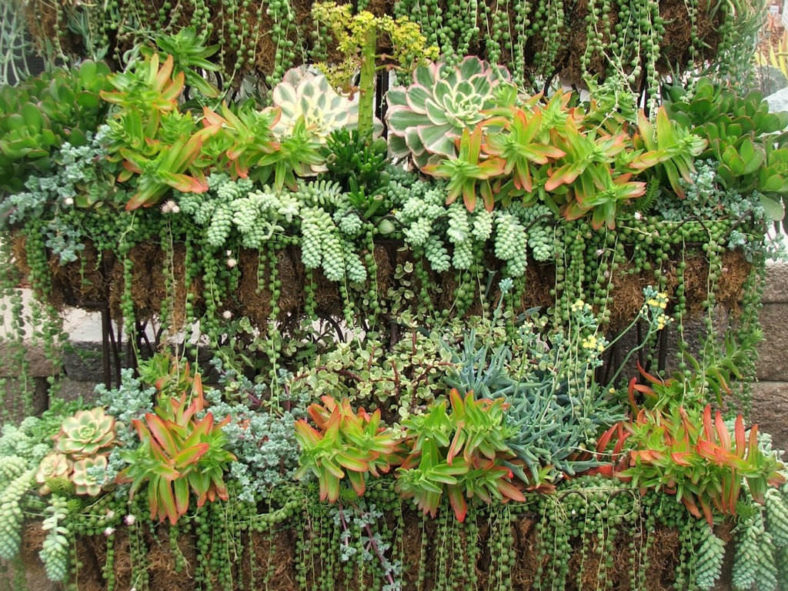Summer can be an ideal season in many of our gardens. However, even the hardiest, drought-tolerant plants, including succulents, will benefit significantly from a small amount of added care in the hot summer days.
Whether your succulents are in containers or the ground, here are some care tips and techniques to help keep your collection looking its best all season long.
Watering
The majority of succulents are NOT desert plants. Almost all need some water year-round. In general, water in-ground plants every ten days to two weeks. More frequent watering is necessary for container-planted succulents. The smaller the container, the more frequent the need for water. Succulents in the 2-inch (5 cm) pots found in many nurseries need water almost every other day. In general, based on the container size and its location, water container succulent gardens once a week.
Remember that black plastic nursery pots significantly increase heat around the plant's root zone and water needs. That is why it is wise to remove your succulents from those containers and plant them into the ground or a more hospitable container.
Water early in the day to allow the plants to dry off and prevent rotting and sunburn. And never allow succulent containers to sit in water.

Sun Exposure
Because most are NOT desert plants, succulents in containers will not appreciate a location in the direct summer sun, especially if your garden is in an inland microclimate. When shopping for succulents at a nursery, you will notice that most are displayed under light shade cloth. At home, locate container succulents near a sunny window. Remember, plants in the sunniest areas will require a bit more water.
If you plan on putting succulents in an area that receives intense summer sun, be sure to acclimatize them gradually, or the leaves will sunburn. Unfortunately, these large, white, brown, or black patches of sunburn cannot be reversed.
If plants start to stretch out towards the sun and become leggy, they likely need more sun than they are getting. Move them, if possible, to a sunnier site.
Rosette-forming succulents like Aeonium and Echeveria that become leggy can be "beheaded" now to allow propagation of the head and possibly new growth of plants along the stem. Suspend the cut head on the edges of an empty flower pot, stem side down, put it in a shady spot, and in a few weeks, you will see tiny root hairs on the stem. Then, plant in a good quality succulent mix.
Pests
Succulents are bothered by a few pests, but those can be annoying, unsightly, and sometimes destructive. Among the most common are mites, mealy bugs, snails, birds, and rodents. Birds and rodents find healthy succulents a good water source, especially during dry periods. Snails love the tender new growth. These pests can be deterred by exclusion or repellants. Bird netting is a good choice if most of your plants are in one area.
Mealybugs are the most common succulent pest. They resemble small white fluff balls, sometimes under the pot rim or at the base of the plants. They can be hosed off, manually removed, or killed with insecticidal soap. Also, check plant roots, as there are root mealybugs, too.
Distorted leaves may mean a plant is infested with spider mites, the second most common pest of succulents.
Some Good Things to Know
Keep the area around succulents, especially rosette forms, free of built-up mulch, leaf debris, and anything that might hold moisture next to the base of the plant. A wet crown will lead to rotting and also attract snails. Overwatering also can cause rotting, especially if there is a series of cold, cloudy days.
Warmer weather causes rapid evaporation. Check your container plants for white salt buildup on the sides and bottoms of the pots. Remove it with a brush.
Most succulents do well inside during the summer. However, do not put them too close to a window with much sun. Water only when the soil is dry.
"Low care" doesn't mean "no care." Check on your succulents' condition regularly to prevent or correct many of the things that keep them from looking their best.
Some succulents are winter growers and may appear ailing or dead during the summer months when they are dormant. Winter growers include Senecio, Kalanchoe, and Dudleya. Avoid excessive watering for these three, especially California native Dudleyas. Early summer is a good time for most succulent families to take cuttings and start propagation. Many succulents will come into flower, and hummingbirds are attracted to their blossoms.
Source: mastergardenerssandiego.org
Links
- Succupedia: Browse succulents by Scientific Name, Common Name, Genus, Family, USDA Hardiness Zone, Origin, or cacti by Genus